The Love Triangle Spread
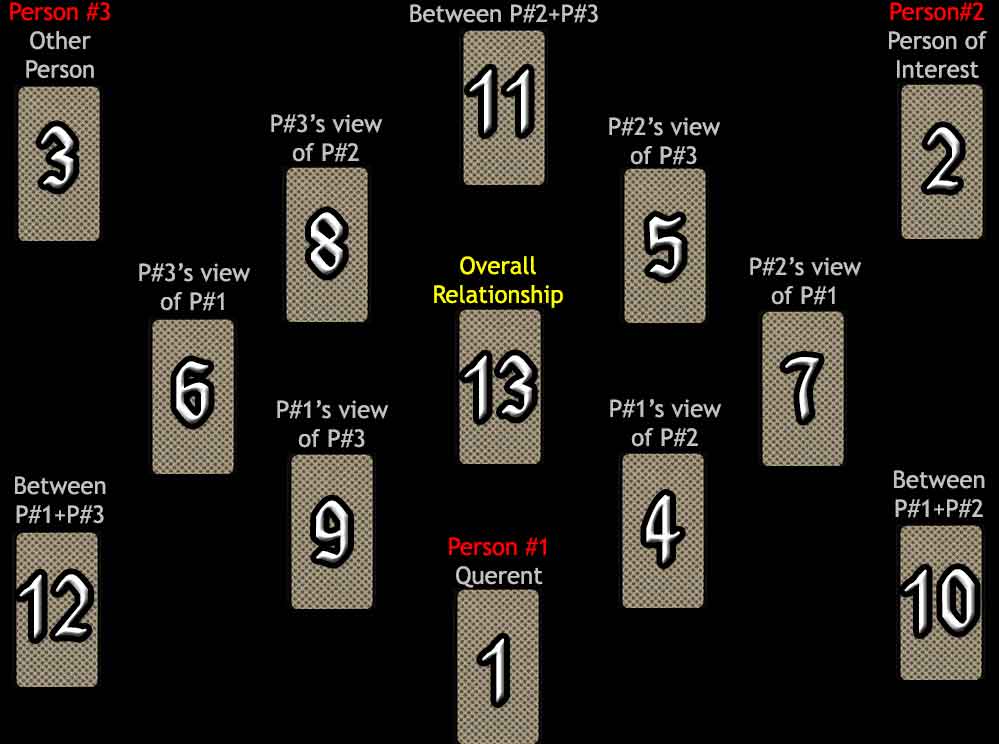
Difficulty: Complicated
Casually referred to as the Love Triangle, this spread can be used to determine the dynamics of the relationship between three people, regardless of whether romance is involved. This spread is arranged in the form of a hexagram, consisting of several large and small triangles. This tarot spread may seem somewhat complicated, but it is not entirely that difficult.
The first step is to interpret the card for each individual position in the spread. Generally, one might ask about a relationship they are involved in, but this does not have to be the case. Ordinarily, the reader's representative card is #1, their main person of interest is #2, and the other person would be #3.
The second step fills in the downward triangle and involves further examination of the individuals through their views of the other people. Each person has two more cards showing the way they see and relate to the other members of the triangle. For example, Card #6 indicates how Person #3 relates to Person #1, while Card #9 stands for Person #1's attitude toward Person #3.
The next step completes the upward triangle and the hexagram, focusing on cards #10–13. It also completes the many smaller triangles and hints at the potential for each relationship. The final card, #13 can be considered the significator of the reading, which suggests the overall potential for this three-way relationship.
Your Love Triangle Reading
| P#3 | 3to2 | 2+3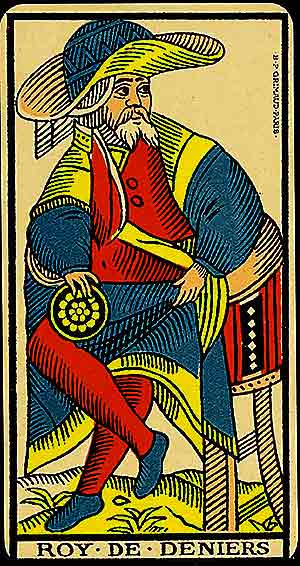 |
2to3 | P#2 | ||
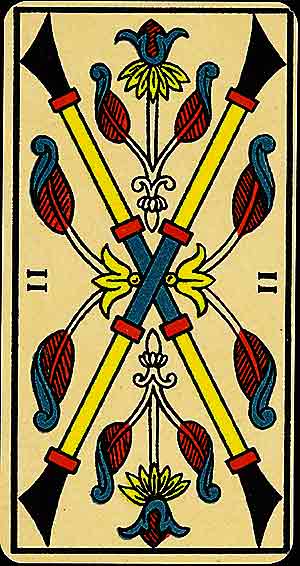 |
3to1 | 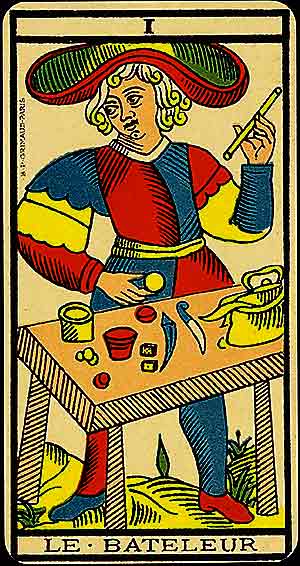 |
Overall | 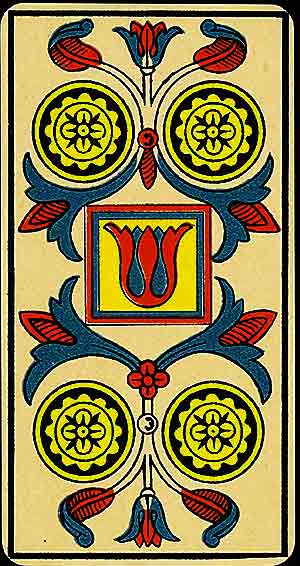 |
2to1 | 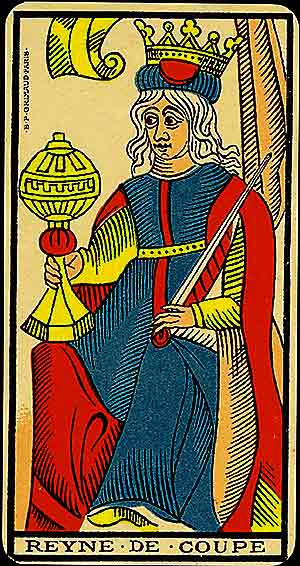 |
| 1+3 | 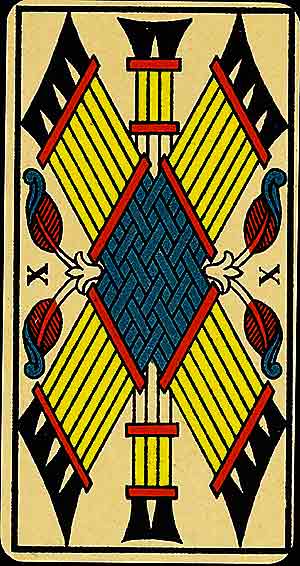 |
1to3 | 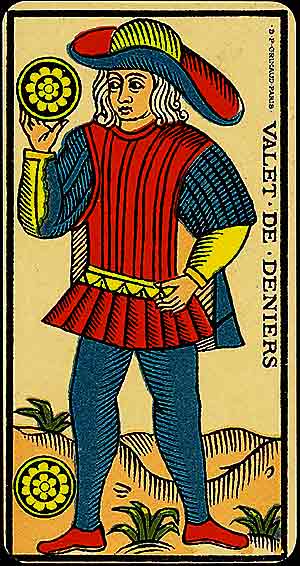 |
1to2 | 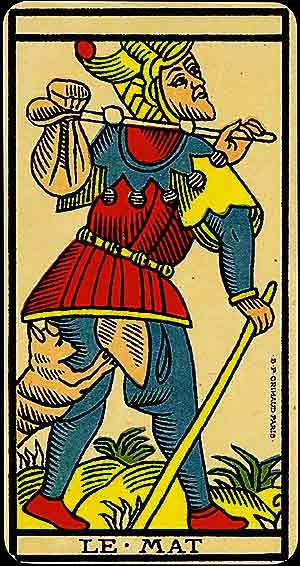 |
1+2 |
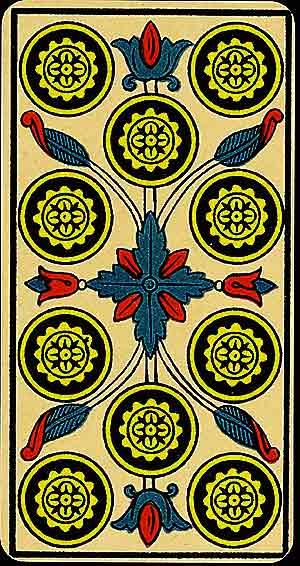 |
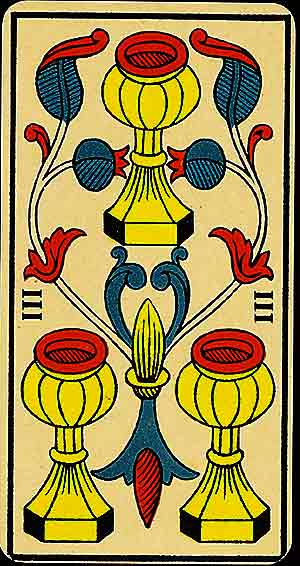 |
P#1 | 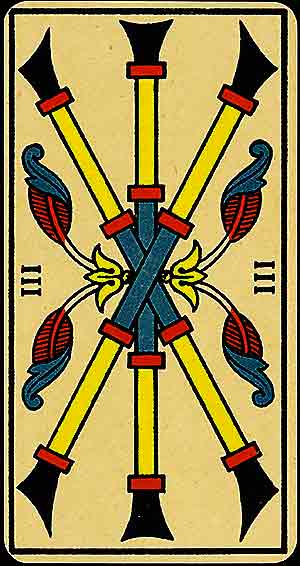 |
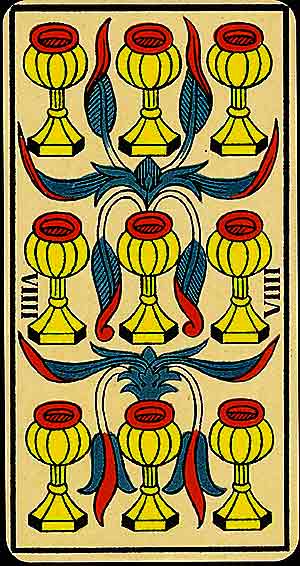 |
||
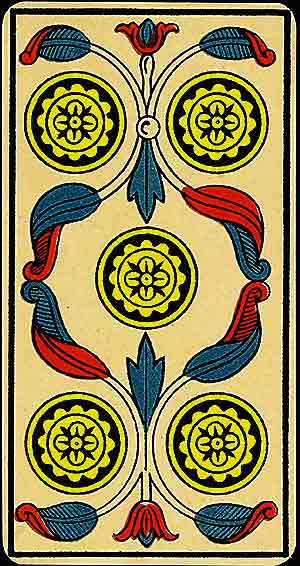 |
1: Person #1

The Five of Coins symbolises hardship, scarcity, and the challenges of material or emotional instability. It invites resilience and the recognition of available support.
Symbolism: Five coins form an X, reflecting imbalance and disruption. The floral embellishments suggest that growth is possible, even in difficult circumstances.
In Relationships: Struggles often involving feelings of neglect or emotional distance. It calls for mutual support and understanding.
In Work: Financial or professional difficulties that require perseverance and resourcefulness.
Spiritually: The card reflects the challenges of feeling disconnected from abundance, urging the seeker to rediscover faith and community.
When ill-dignified: Despair, self-pity, or a refusal to seek help. It warns against isolating yourself during difficult times.
2: Person #2

The Queen of Cups embodies emotional depth, compassion, and intuitive wisdom. She represents the nurturing of emotions and the ability to comfort others.
Symbolism: Seated gracefully on her throne, the Queen holds a beautifully crafted cup, symbolising her mastery over emotions. Surrounding designs evoke her intuitive and healing energy.
In Relationships: This card signifies a loving, empathetic partner or deepening emotional bonds. It encourages open-hearted communication and mutual support.
In Work: The Queen highlights the importance of compassion and emotional intelligence. It suggests a role where empathy and intuition are vital for success.
Spiritually: The Queen reflects the mastery of your inner emotional world and the ability to channel intuition and empathy into healing and guidance.
When ill-dignified: Emotional overwhelm, dependence, or manipulation. It warns against losing yourself in emotions or using your sensitivity to control others.
3: Person #3

The Deuce of Batons represents planning and the initial stages of action. It symbolises the tension between potential paths and the courage required to step forward.
Symbolism: Two batons intersect, adorned with foliage that hints at growth and duality. The symmetry of the design reflects stability but also implies the need for decision-making.
In Relationships: A partnership at a crossroads, where mutual goals must be clarified.
In Work: Strategic planning and weighing options for growth. It's a call to act decisively.
Spiritually: The card signifies a moment of reflection, urging you to align choices with your higher purpose.
When ill-dignified: Indecision, hesitation, or lack of direction. It warns against delaying action because of fear of failure.
4: Person #1's view of #2

The Three of Batons signifies expansion and the realisation of early progress. It is a card of growth through exploration and the courage to venture into new realms.
Symbolism: Three batons interlace harmoniously, with flourishing leaves that reflect growth. The triangular crossing suggests stability in motion, as progress unfolds from a solid foundation.
In Relationships: Relationships flourish through shared aspirations and mutual support. It may indicate exploring new horizons together.
In Work: Initial successes lead to broader opportunities. This card encourages continued effort and long-term vision.
Spiritually: A reminder to expand your perspective and trust the journey towards greater understanding.
When ill-dignified: Frustration or delays in progress. It warns against complacency or overconfidence.
5: Person #2's view of #3

The Four of Coins represents stability, security, and the consolidation of resources. The square flower in the centre suggests a firm foundation but also warns of rigidity or excessive attachment to material possessions.
Symbolism: Four coins form a square, symbolising solidity and structure. The simplicity of the arrangement reflects material grounding, while the lack of movement suggests potential stagnation.
In Relationships: A relationship built on stability, but one that may lack spontaneity. It calls for finding balance between security and emotional openness.
In Work: Financial or professional stability, but a need to avoid becoming overly conservative or resistant to growth.
Spiritually: The card invites you to ground yourself but warns against clinging too tightly to the material world.
When ill-dignified: Greed, possessiveness, or fear of loss. It warns against hoarding resources or stifling growth due to fear of change.
6: Person #3's view of #1

The Ten of Batons symbolises burdens, responsibilities, and the weight of success. It reflects the challenges of carrying too much, but also the potential for completion and fulfilment.
Symbolism: Ten batons form a dense, interwoven framework, with leaves struggling to emerge. The complexity of the design reflects the heavy responsibilities and pressures of achievement.
In Relationships: A relationship burdened by imbalances or external pressures. Communication is key to restoring harmony.
In Work: Overwork or carrying too many responsibilities. Delegation may be necessary to achieve long-term success.
Spiritually: The card invites you to release unnecessary burdens and focus on your spiritual priorities.
When ill-dignified: Overwhelm, failure to delegate, or losing sight of the goal. It warns against taking on more than you can handle.
7: Person #2's view of #1

The Fool represents the untamed spirit and unshackled freedom of the soul. He wanders without boundaries, embodying movement, exploration, and detachment from worldly concerns. This card invites us to embrace change and unpredictability with courage and spontaneity.
Symbolism: The dog biting at the Fool's leg symbolises the tension between freedom and earthly constraints. His staff and bundle represent the burdens and wisdom accumulated on life's journey, carried with both carelessness and purpose. The colourful jester's attire signifies his eccentricity and adaptability, while his forward gaze reflects an openness to the unknown.
In Relationships: A new, unpredictable connection or the need for more spontaneity in existing relationships. Beware of recklessness.
In Work: Embarking on a risky or unconventional path, where intuition takes precedence over plans.
Spiritually: The Fool embodies the soul's leap into the vast unknown, trusting the divine order of chaos.
When ill-dignified: Naivety, poor judgement, or a lack of grounding. It warns of becoming aimless or distracted by superficial pursuits.
8: Person #3's view of #2

The Magician represents skill, potential, and the power to shape reality. As the first step in the Major Arcana, he symbolises the individual's awareness of their tools and the initiation of personal mastery.
Symbolism: The table before him holds simple tools—a cup, a coin, a blade, and a wand—representing the raw elements of life and their mastery. His wide-brimmed hat, resembling the lemniscate, speaks of infinite potential and dynamic creativity. The uneven terrain below mirrors his capacity to balance uncertainty with control.
In Relationships: A time to take initiative or charm your way into new connections. The Magician highlights personal magnetism but warns against manipulation.
In Work: A signal to harness your skills and capitalise on emerging opportunities. Confidence and action are key.
Spiritually: The Magician is the bridge between spirit and matter, teaching you to use divine gifts responsibly.
When ill-dignified: Deception, arrogance, or scattered energy. It warns against using talents for selfish or destructive ends.
9: Person #1's view of #3

The Three of Cups signifies celebration, joy, and the strength of community. It highlights the beauty of shared experiences and collective support.
Symbolism: Three cups are arranged in a triangular formation, adorned with floral embellishments. The triangular structure represents unity and the joy of collaboration, while the flourishing details reflect abundance and festivity.
In Relationships: A period of happiness and shared experiences. It may also signify joyful gatherings.
In Work: Success celebrated with colleagues or recognition of collaborative achievements.
Spiritually: The card encourages gratitude and participation in rituals or practices that foster collective growth and harmony.
When ill-dignified: Overindulgence, superficial connections, or neglecting personal boundaries. It warns against prioritising social validation over genuine connection.
10: Overall relationship between persons #1 and #2

The Nine of Cups is a card of contentment, fulfilment, and the realisation of emotional desires. It is sometimes referred to as the 'wish card', symbolising the joy of achievement.
Symbolism: Nine cups are arranged in a symmetrical, flowing pattern, with flourishing decorations that reflect abundance and satisfaction. The balanced structure suggests harmony and emotional success.
In Relationships: Emotional satisfaction and a harmonious relationship. It may signify a wish fulfilled in love.
In Work: Recognition and rewards for hard work. Enjoy the fruits of your labour and celebrate your achievements.
Spiritually: The card reflects gratitude and alignment with your inner truth, inviting you to celebrate your blessings.
When ill-dignified: Complacency, overindulgence, or self-centredness. It warns against taking emotional fulfilment for granted.
11: Overall relationship between persons #2 and #3

The King of Coins represents mastery, security, and leadership in the material realm. He embodies the culmination of efforts to achieve prosperity and the wisdom to manage it responsibly.
Symbolism: The King sits on his throne, holding a coin against his thigh. His rich attire and the solid, grounded posture of his figure reflect his wealth, stability, and ability to create and sustain abundance. His gaze suggests foresight and the ability to guide others.
In Relationships: A stable, protective partner who values commitment and security. The card encourages cultivating trust and shared goals.
In Work: Leadership, financial success, and the ability to manage resources wisely. This card highlights mastery in your field and the respect of peers.
Spiritually: The King teaches the value of integrating spiritual wisdom with material responsibility, urging you to be a steward of their blessings.
When ill-dignified: Greed, arrogance, or misuse of power. It warns against becoming overly controlling or neglecting emotional connections in pursuit of material gain.
12: Overall relationship between persons #1 and #3

The Ten of Coins symbolises legacy, prosperity, and long-term security. It reflects the culmination of efforts to create a stable and abundant future for yourself and others.
Symbolism: Ten coins are arranged in a pair of X's, forming a harmonious and interconnected pattern. The abundance of detail reflects wealth, tradition, and the enduring rewards of hard work.
In Relationships: A stable and enduring partnership that focuses on building a shared future. It suggests family or community ties.
In Work: The successful completion of a project or the establishment of lasting financial security.
Spiritually: The card reflects the integration of material success with spiritual fulfilment, encouraging gratitude and generosity.
When ill-dignified: Materialism, stagnation, or the fear of losing what has been built. It warns against clinging to tradition at the expense of growth.
13: Overall 3-way Relationship

The Valet of Coins represents curiosity, learning, and the exploration of material opportunities. It reflects a novice's energy, focused on growth and the potential for prosperity.
Symbolism: The Valet stands holding a single coin, examining it attentively. His simple yet fancy attire reflects his connection to practicality and his aspiration towards refinement. His stance suggests openness to new possibilities and a willingness to learn from experience.
In Relationships: A budding relationship or a fresh perspective on an existing one. It may indicate someone earnest and dependable but inexperienced in emotional matters.
In Work: The beginning of a new project, study, or skill development. This card encourages patience and diligence in pursuing goals.
Spiritually: The Valet invites you to ground yourself in practical wisdom while exploring your spiritual path.
When ill-dignified: Procrastination, immaturity, or lack of focus. It warns against undervaluing opportunities or avoiding responsibility.